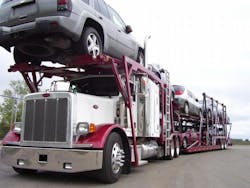Hydraulics moves the ramps and platforms that allow a single carrier to hold multiple cars. Naturally, heavy loads are involved, and the hose must tolerate brutal over-the-road conditions. Typically, car carriers have relied on SAE 100R1 hydraulic hose for pressures to 2250 psi for 3⁄8-in. hose (to 2000 psi for 1⁄2-in. hose) and SAE 100R2 for pressures to 4000 psi for 3⁄8-in. hose (3500 for 1⁄2-in. hose). However, the pressure rating for one manufacturer’s proprietary hydraulic hose is 2750 psi for the 3⁄8-in. size and 2500 psi for 1⁄2 in.
The higher pressure rating means manufacturers can specify the hose when pressure exceeds the capacity of standard 100R1 hose by up to 500 psi without going to the heavier, bulkier, and more-costly 100R2 hose. Even without the higher pressure rating, the proprietary hose has a smaller OD (0.65 in. instead of 0.713 in. for 3⁄8-in. size; 0.81 versus 0.846 for 1⁄2-in. size) than 100R1 hose. Moreover, it has a tighter bend radius (21⁄4-in. instead of 5 in. for the 3⁄8-in. size; 31⁄4 in. versus 7 in. for 1⁄2 in.) than 3⁄8- and 1⁄2-in. 100R1 and R2 hose. In cases where it would replace 100R2 hose, the proprietary offers a smaller OD than the 0.777 and 0.908 in. of 3⁄8- and 1⁄2-in. hose, respectively. This simplifies design by allowing the proprietary hose to be routed through smaller passages and in more confined areas.
Because a typical carrier uses so much hose, reducing the weight of hose becomes important as potential fuel savings. Assuming the average carrier uses 4000 ft of hose—1000 ft each of 3⁄8 and 1⁄2-in. 100R1 and 100R2—the weight of hose alone would amount to 1340 lb. Weight of the proprietary hose is only 0.15 lb/ft for the 3⁄8-in. size and 0.20 lb/ft for 1⁄2-in. hose. So if the same theoretical car carrier used the proprietary hose instead of 100R1 and 25% of the 100R2, the weight of hose would be cut to 995 lb—a reduction of nearly one-third. Weight reductions range from 35% less than 3⁄8-in. 100R1 hose to 55% less than 1⁄2-in. 100R2 hose.
Compact but tough
Another consideration is durability. Car carriers must operate under a wide variation of environments. Hose may be subjected to temperatures down to –40° when transporting cars during the frigid winters of Minnesota, or be baked by temperatures of 120° F or higher — plus ultraviolet radiation — when subjected to a scorching Arizona summer. Add to this sand, dirt, road grime, ice, snow, and hail bombarding the hose at highway speeds, and you realize how tough a hose cover must be. Standard testing for hose-to-hose abrasion has revealed that 100R1 hose undergoes roughly 312,000 cycles before replacement becomes necessary. Under the same tests the proprietary hose survived about four times the cycles before the same wear was observed.
An alternative to the proprietary wire-reinforced hose is thermoplastic hose, which also has a compact OD, but the thermoplastic construction and fiber reinforcement offer even more weight reduction and tighter bend radii. Another benefit provided by fiber reinforcement is improved life because the hose does not undergo the built-in fatigue life of wire reinforced hose.
SAE Publication J517 provides general, dimensional, and performance specifications for the most common hoses used in hydraulic systems on mobile and stationary equipment. The specifications it provides apply to all hydraulic hoses and supplement the detailed specifications for the 100R-series hoses contained in the document. List price for SAE J517 is $66, with discounts for SAE members. To order, call SAE at (724) 776-4970 or click here.


